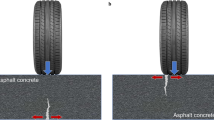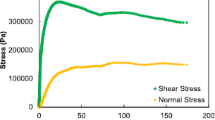Abstract
Pavement analysis and design for fatigue cracking involves a number of practical problems like material assessment/screening and performance prediction. A mechanics-aided method can answer these questions with satisfactory accuracy in a convenient way when it is appropriately implemented. This paper presents two techniques to implement the pseudo J-integral based Paris’ law to evaluate and predict fatigue cracking in asphalt mixtures and pavements. The first technique, quasi-elastic simulation, provides a rational and appropriate reference modulus for the pseudo analysis (i.e., viscoelastic to elastic conversion) by making use of the widely used material property: dynamic modulus. The physical significance of the quasi-elastic simulation is clarified. Introduction of this technique facilitates the implementation of the fracture mechanics models as well as continuum damage mechanics models to characterize fatigue cracking in asphalt pavements. The second technique about modeling fracture coefficients of the pseudo J-integral based Paris’ law simplifies the prediction of fatigue cracking without performing fatigue tests. The developed prediction models for the fracture coefficients rely on readily available mixture design properties that directly affect the fatigue performance, including the relaxation modulus, air void content, asphalt binder content, and aggregate gradation. Sufficient data are collected to develop such prediction models and the R 2 values are around 0.9. The presented case studies serve as examples to illustrate how the pseudo J-integral based Paris’ law predicts fatigue resistance of asphalt mixtures and assesses fatigue performance of asphalt pavements. Future applications include the estimation of fatigue life of asphalt mixtures/pavements through a distinct criterion that defines fatigue failure by its physical significance.









Similar content being viewed by others
References
Rowe GM (1993) Performance of asphalt mixtures in the trapezoidal fatigue test. J Assoc Asphalt Paving Technol 62:344–384
Kim YR, Wen H (2002) Fracture energy from indirect tension testing. J Assoc Asphalt Paving Technol 71:779–793
Jacobs MMJ (1995) Crack growth in asphaltic mixes. PhD dissertation, the Delft University of Technology, The Netherlands
Kuai H, Lee HJ, Zi G, Mun S (2009) Application of generalized J-integral to crack propagation modeling of asphalt concrete under repeated loading. Transp Res Rec 2127:72–81
Lytton RL, Roque RL, Uzan J, Hiltunen DR, Fernando E, Stoffels SM (1993) Performance models and validation of test results. Final Report. Asphalt Project A-005. Strategic Highway Research Program, National Research Council, Washington, DC
Zhang Z, Roque R, Birgisson B (2001) Evaluation of laboratory-measured crack growth rate for asphalt mixtures. Transp Res Rec 767:67–75
Christensen DW, Bonaquist R (2005) Practical application of continuum damage theory to fatigue phenomena in asphalt concrete mixtures. J Assoc Asphalt Paving Technol 74:963–1002
Park SW, Kim YR, Schapery RA (1996) A viscoelastic continuum damage model and its application to uniaxial behavior of asphalt concrete. Mech Mater 24(4):241–255
Collop AC, Scarpas A, Kasbergen C, de Bondt A (2003) Development and finite element implementation of stress-dependent elastoviscoplastic constitutive model with damage for asphalt. Transp Res Rec 1832:96–104
Dai Q, Sadd M, Parameswaran V, Shukla A (2005) Prediction of damage behaviors in asphalt materials using a micromechanical finite-element model and image analysis. J Eng Mech 131(7):668–677
ARA, Inc. (2004) Guide for mechanistic-empirical design of new and rehabilitated pavement structure. Draft Final Report 1-37A. National Cooperative Highway Research Program, Transportation Research Board, Washington, DC
Hu S, Zhou F, Scullion T (2014) Development of Texas Mechanistic-Empirical Flexible Pavement Design System (TxME). FHWA/TX-14/0-6622-2. Texas A&M Transportation Institute, College Station
Zhou F, Fernando E, Scullion T (2010) Development, calibration, and validation of performance prediction models for the Texas M-E flexible pavement design system. FHWA/TX-10/0-5798-2. Texas A&M Transportation Institute, College Station
Underwood BS, Baek C, Kim YR (2012) Simplified viscoelastic continuum damage model as platform for asphalt concrete fatigue analysis. Transp Res Rec 2296:36–45
Kutay ME, Gibson N, Youtcheff J, Dongré R (2009) Use of small samples to predict fatigue lives of field cores. Transp Res Rec 2127:90–97
Schapery RA (1984) Correspondence principles and a generalized J integral for large deformation and fracture analysis of viscoelastic media. Int J Fract 25:195–223
Zhang Y, Luo R, Lytton RL (2012) Characterizing permanent deformation and fracture of asphalt mixtures by using compressive dynamic modulus tests. J Mater Civil Eng 24(7):898–906
Luo X, Luo R, Lytton RL (2013) Characterization of fatigue damage in asphalt mixtures using pseudo strain energy. J Mater Civil Eng 25(2):208–218
Luo X, Luo R, Lytton RL (2014) Energy-based crack initiation criterion for viscoelastoplastic materials with distributed cracks. J Eng Mech 141(2):04014114
ASTM (2003) Standard test method for dynamic modulus of asphalt mixtures. ASTM D3497, West Conshohocken
Underwood BS, Kim YR (2009) Determination of the appropriate representative elastic modulus for asphalt concrete. Int J Pavement Eng 10(2):77–86
Luo X, Luo R, Lytton RL (2013) Characterization of asphalt mixtures using controlled-strain repeated direct tension test. J Mater Civil Eng 25(2):194–207
Luo X, Luo R, Lytton RL (2013) Characterization of recovery properties of asphalt mixtures. Constr Build Mater 48:610–621
Findley WN, Lai JS, Onaran K (1989) Creep and relaxation of nonlinear viscoelastic materials: with an introduction to linear viscoelasticity. Dover Publications, New York
Luo X, Luo R, Lytton RL (2013) A modified paris’ law to predict entire crack growth in asphalt mixtures. Transp Res Rec 2373:54–62
Anderson TL (2005) Fracture mechanics: fundamentals and applications. CRC Press, Boca Raton
Gu F, Zhang Y, Luo X, Luo R, Lytton RL (2014) Improved methodology to evaluate fracture properties of warm mix asphalt using overlay test. Transp Res Rec 2506:8–18
Jones DR (1993) SHRP Report A-645: Materials Reference Library: asphalt cements: a concise data compilation. TRB, National Research Council, Washington, DC
Roberts FL, Kandhal PS, Brown ER, Lee DY, Kennedy TW (1996) Hot mix asphalt materials, mixture design, and construction. National Asphalt Paving Association Education Foundation, Lanham
Zhang Y, Luo X, Luo R, Lytton RL (2014) Crack initiation in asphalt mixtures under external compressive loads. Constr Build Mater 72:94–103
Author information
Authors and Affiliations
Corresponding author
Rights and permissions
About this article
Cite this article
Luo, X., Zhang, Y. & Lytton, R.L. Implementation of pseudo J-integral based Paris’ law for fatigue cracking in asphalt mixtures and pavements. Mater Struct 49, 3713–3732 (2016). https://doi.org/10.1617/s11527-015-0750-z
Received:
Accepted:
Published:
Issue Date:
DOI: https://doi.org/10.1617/s11527-015-0750-z




